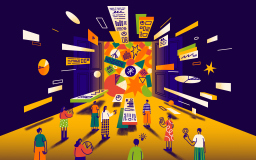The right way to structure a UX research report

I spent hours staring at blank Google Docs or Google Slides when creating a user research presentation. Finally, it got to the point where, instead of focusing on the actual content, I decided to try a plethora of tools and templates to help me.
It wasn’t that I didn’t know what to write. I didn’t have the right color palette or beautiful graphics (I’m not a designer, after all). So I tried notes, Notion, Miro, some obscure tools that no longer exist, and I downloaded an obscene number of Keynote and Google Slide templates. There was even a point where I bought slide templates on Etsy.
However, the real problem was not the formatting, design, or aesthetic of my research reports—as much as I wished it was because that was a lot easier to solve than the real problem. I had no idea how to structure my research reports. I was constantly faced with writer’s block, staring at the blank pages, knowing that I had to present findings and the clock was ticking. Nothing is more complex than creating something from scratch.
After years of agonizing over reports, I finally started to find my rhythm and cadence. I unlocked the first step in adequately structuring research reports: knowing your audience. Writing hundreds of reports has helped me see the main ways stakeholders like to ingest research information. Now, I use three primary templates, which speed up my process and allow the data to shine.
Structure by research themes
The first and most common way of structuring reports is by themes. In this structure, you use what you learned from synthesis to guide how you write the report. But what exactly is a theme?
After affinity diagramming, you will have clusters of information. For example, if I conducted a study on how people decide on where to travel next, I might see the following groups come up:
Inspiration from social media (Instagram, blogs)
Recommendations from friends, family, or communities
Going to a place you’ve been before and enjoyed
Using package or vacation deals
Partner, spouse, or friend wanting to travel somewhere specific
Discounted trip finders
Choosing from a bucket list of destinations
Randomly selecting a destination that sounds cool
Now, that is a lot to report on in and of itself! If I could help the team better understand this decision, I would focus on the top three to five themes with the highest number of participants. Let’s say I spoke to 20 people, and the top three decision-making factors were:
Inspiration from social media (Instagram, blogs)—17/20 participants
Recommendations from friends, family, or communities—14/20 participants
Using discounted trip finders—13/20 participants
I would use these three themes as the structure of my report, starting with the most common theme and ending with the least. Within the report, I would include:
Theme title
Theme summary, which includes bullet points of the main one to three findings within the theme
A deep dive section, including the insight behind the finding, quotes, videos, or audio clips of each finding
So, this would then look like this:
Theme title: Inspiration from social media
Theme summary:
Finding one: People follow travel influencers on social media (e.g., Instagram and blogs) to constantly be up-to-date on where to travel next
Finding two: People create lists, boards, or collections to save all the destinations they find from influencers or on social media and return to them when they want to travel
Deep dive into finding one:
Many people love to daydream about travel, and there isn’t a better way to do that than getting lost on social media. Jake opens Instagram during work one day because he overheard a colleague talking about a recent trip. Jake knows he has some vacation days left, so he goes to his favorite Instagram travel accounts and starts scrolling. He remembers he started collecting a few places he’d like to go and looks through them, deciding on the top two. He makes a note to look up the prices later tonight, after work, and look into some potential dates. Although he wishes he could book the trip right then and there, it is too complicated to do during work, so he waits until later.
“Yeah, I just got this travel bug suddenly after I heard some people talking, and as soon as I saw the photos on Instagram, I was like, I have to go. I wish I could have just booked it immediately, but figuring out dates, airlines, hotels, and budget takes focus, so I just look into it when I have more time.”
By following this structure, you can lay out the most important information you found for stakeholders to quickly get the most critical findings.
Research goals and questions
I used the theme template frequently for quite a few years, without deviating much. However, I still saw confusion at times with some stakeholders. With this structure, the answers to their questions or the research goals weren’t always straightforward. I then decided to try another format.
Instead of organizing the findings by themes gathered in clusters, I went straight to answering the research goals or questions aligned on at the beginning of the project. The incredible impact of this structure was that it directly answered what the stakeholders needed to know.
If we take the example from above, let’s say the research goals were to:
Understand people’s current mental models around deciding on where to travel to next
Discover pain points behind deciding on where to travel
Identify the tools people currently use when getting inspired and deciding on where to travel to next
So, instead of grouping by themes, I would structure it like:
Research goal one title
Finding summary, which includes bullet points of the one to three findings relevant to the goal
Finding one directly related to the research goal
Evidence of finding one
Finding two directly related to the research goal
Evidence of finding two
Finding three directly related to the research goal
Evidence of finding three
This way, the evidence you present is directly related to the study’s goals and the information stakeholders need to make decisions. Take a look at my sample UX research report template here (in exchange for your email, please)!
Usability testing
Now, I have found that usability testing is its own type of report and template. So I use one of the initial templates but then add a separate component that analyzes the usability aspect. Since it is slightly more manageable, I usually use the theme template to begin my usability test and then dive into the prototype findings. Still, I usually only highlight the top two themes to ensure the presentation isn’t too long.
The main difference here is the concept/prototype analysis section. There are a few ways to structure analysis when it comes to usability testing. The two main ways I have had success with are:
Screen-by-screen analysis, which includes a photo of the screen and annotations of feedback
A flow analysis, which includes bullet points of feedback
If you are doing any quantitative usability testing, such as measuring time on task or task success, include a stoplight chart
The way I decide whether to use screen-by-screen or flow analysis depends on the stakeholders’ needs and the depth of feedback I received from participants. For example, if I find that each screen received a lot of feedback, I will do that analysis. However, if the team needs to understand the flow of the prototype, I will break that up into several slides to demonstrate the feedback on the overall flow.
So my usability testing reports are generally structured like:
Theme title one
Theme summary, which includes bullet points of the main one to three findings within the theme
A deep dive section, including the insight behind the finding, quotes, videos, or audio clips of each finding
Theme title two
Theme summary, which includes bullet points of the main one to three findings within the theme
A deep dive slide, behind the finding, quotes, videos, or audio clips of each finding
Concept/prototype analysis
Reminder of the prototype
Screen-by-screen or flow analysis
If applicable, a rainbow chart
These three structures cover the most common reports/presentations you will encounter as a user researcher. I highly encourage you to try different approaches within these structures by always thinking of your audience first and gathering feedback after each presentation!
If you’re a Dovetail Analysis+Repository or Enterprise customer, you can make awesome-looking reports in Dovetail using Stories. Check out our guide for building beautiful reports here.




